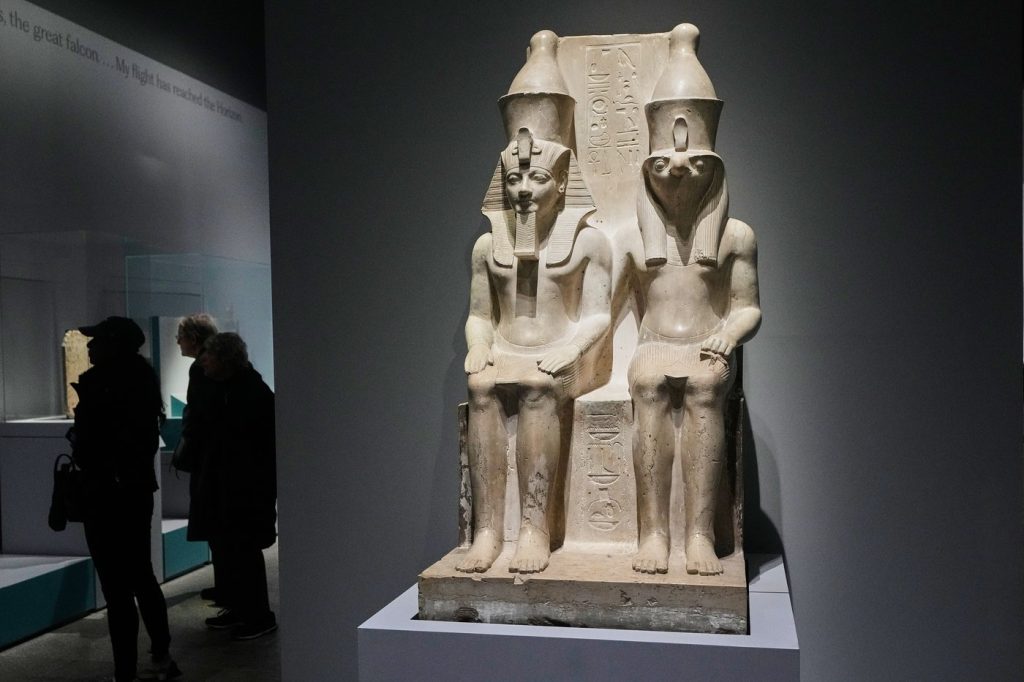NEW YORK (AP) – The ancient gods of Egypt have come together in a remarkable exhibition titled "Divine Egypt," hosted by the Metropolitan Museum of Art on Manhattan's Upper East Side. This exhibition marks the first major exploration of ancient Egyptian deities at the Met in over a decade, drawing significant crowds since its opening on October 12, 2023. The exhibition offers a lavish presentation of how these gods were portrayed in ancient Egyptian culture, captivating museum-goers with artifacts that span over 3,000 years of civilization.
Diana Craig Patch, the Met's curator of Egyptian art, emphasizes the public's fascination with ancient Egypt, a culture typically first introduced to students through lessons on pyramids, mummies, and the famed tomb of Tutankhamun. "Divine Egypt" seeks to deepen visitors’ understanding by focusing on the representations of deities, not just within the confines of temples accessible only to royalty and priests, but also through daily worship by the common people.
The exhibition features more than 200 artifacts, including imposing limestone statues and delicate golden figurines. It aggregates 140 works from the Met's collection and additional pieces borrowed from museums worldwide. According to Patch, the ancient Egyptian pantheon is vast and complex, with over 1,500 deities depicted through various historical periods, although the exhibition focuses specifically on 25 primary deities. The intricate nature of Egyptian mythology and the ongoing incorporation of new gods into their worship illustrates a dynamic culture that continually evolved.
Key highlights of the exhibition include iconic figures such as Amun-Re and Tutankhamun. A striking greeting at the entrance showcases a sculpture of Amun-Re, depicted in a protective posture over the young pharaoh Tutankhamun. Revered as the solar god, Amun-Re's presence dominates this display, serving as a testament to his significance in Egyptian mythology and his worship at the Karnak temple complex.
The first gallery, titled "Expressing the Divine," delves into the representations of Horus, often illustrated as a falcon, and Hathor, a goddess embodying fertility and music. The artistic flexibility in representing these gods underscores their multifaceted roles within Egyptian culture, where gods could be portrayed in numerous forms based on different contexts.
Another gallery, dedicated to the sun god Re, emphasizes his pivotal role as a creator deity. Re is artistically characterized through various mediums, including a large scarab beetle, symbolizing his power to deliver sunlight from the underworld to the sky. The gallery also features a painted relief of the goddess Maat, representing truth and social order, underscoring her importance in maintaining cosmic balance.
The exhibit further explores the diverse myths of creation, revealing the rich tapestry of beliefs that ancient Egyptians held regarding their origins. This section showcases a massive statue of Min, a lesser-known god associated with fertility and vegetation, indicating the complexity and variation within Egyptian cosmology.
Two significant areas focus on how the common public engaged with the divine. Curators illustrate how ordinary Egyptians participated in festivals when deities were brought into the streets for communal worship. Among the standout pieces in these displays is a gold statuette of Amun, representing the intersection of divine interaction in everyday life.
The "Overcoming Death" gallery addresses the profound relationship Egyptians had with death and the afterlife. Artifacts in this section highlight deities such as Anubis, who facilitated embalming and guided souls in their journey after death, and Osiris, the revered lord of the afterlife. The signature piece of the exhibition is a striking statuette depicting Osiris alongside Isis and Horus, showcasing the artistry associated with their divine representations.
Patch notes that while the final section deals with the theme of death, the overarching narrative of the exhibition is rooted in the celebration of life, reflecting the Egyptian pursuit of immortality. This exploration of divine relationships and the cultural fabric of ancient Egypt provides an enriching experience for all visitors, emphasizing that these ancient beliefs continue to resonate with modern existential inquiries.










